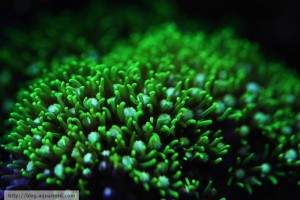As a beginner reef keeper, the thought about corals growing to nuisance levels may never cross your mind. As you hone your skills as an aquarist and your reef matures, some of the corals that you bought as a “newbie” might become a nuisance. Most new aquarium hobbyists would kill for fast growing corals, but be careful what you wish for. A lot of soft corals and even some hard corals can grow and reproduce very rapidly, dominating your tank with only a small handful of different species. Not only do invading corals make your tank look boring, but they can also kill or inhibit other types of corals as well.
Most newbie saltwater aquarium keepers go for the flowy soft corals because they are both colorful and easy to care for usually. A lot of these corals are purchased as test corals whose primary goal is to introduce the former FOWLR (Fish Only With Live Rock) aquarist to the world of reefs. Green star polyps for example are a beginner’s favorite. They can be a very attractive glowing neon green, will grow very quickly, and don’t require anything special. The aquarist usually has the mentality that if they can’t keep these alive, they’re doing something wrong. It’s not a bad idea to slowly introduce corals and test yourself one step at a time. But down the road, those first corals are growing like crazy, killing nearby corals, and the reef keeper can’t get them out.
Continue reading below to find out how to remove out of control corals.
Kenya Tree Coral from AquariumPix
The aquarist is trying to venture into a new realm of corals and hard coral growth becomes inhibited by some softies. At the same time, they are battling Kenya Tree babies that are popping up all over the place and Galaxea corals that are stinging absolutely everything within reach. So how does one go about removing these nuisances? Sure, you could tear down the tank and remove the coral. But nobody wants to completely tear down what they’ve been working so hard on for such a long time. There are two routes the aquarist can take to help, but both of them will require some effort.
Option one is the more humane route. Frag! Cut back the corals as much and as often as required and sell or donate the frags to fellow aquarists. This route will require constant upkeep if you want to keep the soft corals at bay. You will probably never remove the corals 100%, as tiny bits and pieces go unnoticed and eventually regrow into mini colonies. The second option is probably more effective at ridding your aquarium of the pest coral entirely, but it’s a bit on the harsh side.
Blue Anthelia from AquariumPix
If coral pruning isn’t up your alley, you could try killing them. I don’t like this route at all, but for some reefers it seems like the only option. To do this safely, treat the coral as if it were a Majano anemone. Inject corals with lemon juice or cover them with a paste of kalkwasser. Of course there will be side effects from this process. Dead coral tissue will lead to an ammonia spike while overdosing kalkwasser can kill your entire tank if you’re not careful. Again, I do not condone this method of coral control, but it is an option.
Regardless of which route you tank and what corals you are trying to rid your tank of, someone out there wants what you have. They are willing to take on fast growing nuisance corals just like you did when you first got into reef keeping, so take the human route if you can.









Pingback: What eats Japanese Clove Polyps?! - 3reef Reef Aquarium Forum()